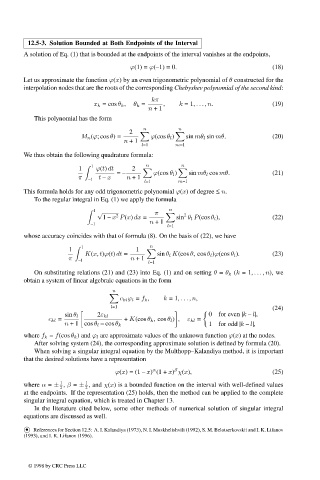Page 649 - Handbook Of Integral Equations
P. 649
12.5-3. Solution Bounded at Both Endpoints of the Interval
A solution of Eq. (1) that is bounded at the endpoints of the interval vanishes at the endpoints,
ϕ(1) = ϕ(–1) = 0. (18)
Let us approximate the function ϕ(x) by an even trigonometric polynomial of θ constructed for the
interpolation nodes that are the roots of the corresponding Chebyshev polynomial of the second kind:
kπ
x k = cos θ k , θ k = , k =1, ... , n. (19)
n +1
This polynomial has the form
n n
2
M n (ϕ; cos θ)= ϕ(cos θ l ) sin mθ l sin mθ. (20)
n +1
l=1 m=1
We thus obtain the following quadrature formula:
n
n
1 1 ϕ(t) dt 2
= – ϕ(cos θ l ) sin mθ l cos mθ. (21)
π –1 t – x n +1
l=1 m=1
This formula holds for any odd trigonometric polynomial ϕ(x) of degree ≤ n.
To the regular integral in Eq. (1) we apply the formula
n
1 √ π
2
2
1 – x P(x) dx = sin θ l P(cos θ l ), (22)
–1 n +1
l=1
whose accuracy coincides with that of formula (8). On the basis of (22), we have
n
1 1 1
K(x, t)ϕ(t) dt = sin θ l K(cos θ, cos θ l )ϕ(cos θ l ). (23)
π –1 n +1
l=1
On substituting relations (21) and (23) into Eq. (1) and on setting θ = θ k (k =1, ... , n), we
obtain a system of linear algebraic equations in the form
n
c kl ϕ l = f k , k =1, ... , n,
l=1 (24)
sin θ l 2ε kl 0 for even |k – l|,
c kl = + K(cos θ k , cos θ l ) , ε kl =
n +1 cos θ l – cos θ k 1 for odd |k – l|,
where f k = f(cos θ k ) and ϕ l are approximate values of the unknown function ϕ(x) at the nodes.
After solving system (24), the corresponding approximate solution is defined by formula (20).
When solving a singular integral equation by the Multhopp–Kalandiya method, it is important
that the desired solutions have a representation
α
β
ϕ(x)=(1 – x) (1 + x) χ(x), (25)
1
1
where α = ± , β = ± , and χ(x) is a bounded function on the interval with well-defined values
2 2
at the endpoints. If the representation (25) holds, then the method can be applied to the complete
singular integral equation, which is treated in Chapter 13.
In the literature cited below, some other methods of numerical solution of singular integral
equations are discussed as well.
•
References for Section 12.5: A. I. Kalandiya (1973), N. I. Muskhelishvili (1992), S. M. Belotserkovskii and I. K. Lifanov
(1993), and I. K. Lifanov (1996).
© 1998 by CRC Press LLC
© 1998 by CRC Press LLC
Page 632

